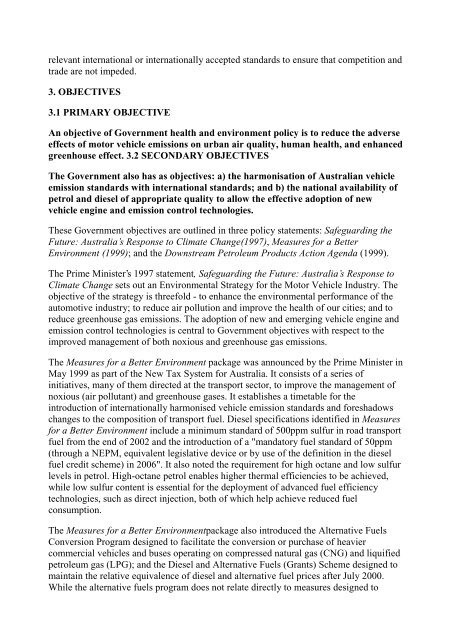National Fuel Quality Standards Regulation Impact Statement 1 ...
National Fuel Quality Standards Regulation Impact Statement 1 ...
National Fuel Quality Standards Regulation Impact Statement 1 ...
Create successful ePaper yourself
Turn your PDF publications into a flip-book with our unique Google optimized e-Paper software.
elevant international or internationally accepted standards to ensure that competition and<br />
trade are not impeded.<br />
3. OBJECTIVES<br />
3.1 PRIMARY OBJECTIVE<br />
An objective of Government health and environment policy is to reduce the adverse<br />
effects of motor vehicle emissions on urban air quality, human health, and enhanced<br />
greenhouse effect. 3.2 SECONDARY OBJECTIVES<br />
The Government also has as objectives: a) the harmonisation of Australian vehicle<br />
emission standards with international standards; and b) the national availability of<br />
petrol and diesel of appropriate quality to allow the effective adoption of new<br />
vehicle engine and emission control technologies.<br />
These Government objectives are outlined in three policy statements: Safeguarding the<br />
Future: Australia’s Response to Climate Change(1997), Measures for a Better<br />
Environment (1999); and the Downstream Petroleum Products Action Agenda (1999).<br />
The Prime Minister’s 1997 statement, Safeguarding the Future: Australia’s Response to<br />
Climate Change sets out an Environmental Strategy for the Motor Vehicle Industry. The<br />
objective of the strategy is threefold - to enhance the environmental performance of the<br />
automotive industry; to reduce air pollution and improve the health of our cities; and to<br />
reduce greenhouse gas emissions. The adoption of new and emerging vehicle engine and<br />
emission control technologies is central to Government objectives with respect to the<br />
improved management of both noxious and greenhouse gas emissions.<br />
The Measures for a Better Environment package was announced by the Prime Minister in<br />
May 1999 as part of the New Tax System for Australia. It consists of a series of<br />
initiatives, many of them directed at the transport sector, to improve the management of<br />
noxious (air pollutant) and greenhouse gases. It establishes a timetable for the<br />
introduction of internationally harmonised vehicle emission standards and foreshadows<br />
changes to the composition of transport fuel. Diesel specifications identified in Measures<br />
for a Better Environment include a minimum standard of 500ppm sulfur in road transport<br />
fuel from the end of 2002 and the introduction of a "mandatory fuel standard of 50ppm<br />
(through a NEPM, equivalent legislative device or by use of the definition in the diesel<br />
fuel credit scheme) in 2006". It also noted the requirement for high octane and low sulfur<br />
levels in petrol. High-octane petrol enables higher thermal efficiencies to be achieved,<br />
while low sulfur content is essential for the deployment of advanced fuel efficiency<br />
technologies, such as direct injection, both of which help achieve reduced fuel<br />
consumption.<br />
The Measures for a Better Environmentpackage also introduced the Alternative <strong>Fuel</strong>s<br />
Conversion Program designed to facilitate the conversion or purchase of heavier<br />
commercial vehicles and buses operating on compressed natural gas (CNG) and liquified<br />
petroleum gas (LPG); and the Diesel and Alternative <strong>Fuel</strong>s (Grants) Scheme designed to<br />
maintain the relative equivalence of diesel and alternative fuel prices after July 2000.<br />
While the alternative fuels program does not relate directly to measures designed to
















